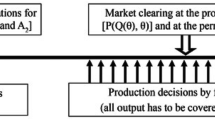Abstract
The article investigates four alternative allocation schemes for emission allowances. The investigated schemes are emission-based allocation, production-based allocation with actor-specific emission factors, production-based allocation with benchmarking and production-based allocation based on data on best available technology (BAT). All the examined schemes apply free allocation based on historical activities. The allocation schemes are evaluated against the criteria for a National Allocation Plan, listed in the Annex III of the EU ETS Directive, and regarding their conformity with the criteria put forward by the Swedish Parliamentary Delegation on Flexible Mechanisms, The FlexMex 2 Commission.
No allocation scheme unambiguously meets all criteria. Each has its advantages and disadvantages. Emission-based allocation schemes are most straightforward, transparent and are the easiest to implement.
Production-based allocation schemes meet more of the criteria, but are more costly to implement and require more data. Data on BAT will not be available to the extent necessary in order to base an allocation scheme implemented for the trading starting 2005 on BAT. It is unlikely that any given allocation scheme will be perceived as fair by all concerned parties, no matter how sophisticated it is. The overall characteristics of the studied allocation schemes are summarised in the paper. Due to the lack of abatement cost curves, it is not possible to accurately model capital flows between the trading sectors. Data availability will most probably limit the options available to the authorities designing the allocation schemes.
Similar content being viewed by others
References
Axelsson, L.-E.: 2002, Personal Communication, Swedish Forest Industries Federation, Box 16006, SE-103 21 Stockholm, Sweden.
Brinck, L.: 2002, Personal Communication, Scanraff Skandinaviska Raffinaderi AB Scanraff, SE-453 81 Lysekil, Sweden.
Brinkhoff, J.: 2002, Personal Communication, Ministry of Economic Affairs, The Netherlands.
Burtraw, D., Palmer, K., Bharvikar, R. and Paul, A.: 2002, ‘,The effect on asset value of the allocation of carbon dioxide emission allowances’, Discussion Paper 02-15, Resources for the Future, Washington D.C.
Capros, P. and Mantzos, L.: 2000, The Economic Effects of EU-Wide Industry-Level Emission Trading to Reduce Greenhouse Gases – Results from PRIMES Energy Schemes Model. Institute of Communications and Computer Schemes of National Technical University of Athens.
de Beer, J., Phylipsen, D. and Bates, J.: 2001, Economic Evaluation of Carbon Dioxide and Nitrous Oxide Emission reductions in Industry in the EU, Bottom up Analysis, Ecofys, The Netherlands, AEA Technology Environment, United Kingdom.
Diczfalusy, B.: 2002, Personal Communication, Confederation of Swedish Enterprise, SE-114 82 Stockholm, Sweden.
EU: 2003, Directive 2003/.../EC of the European Parliament and of the Council Establishing a Scheme for Greenhouse Gas Emission Allowance Trading Within the Community and Amending Council Directive 96/61/EC, Provisional, unofficial version.
FIELD: 2002, Designing Options for Implementing an Emissions Trading Regime for Greenhouse Gases in the EC, Commission for the EU Commission, Brussels, Belgium.
Granström, P.-O.: 2002, Personal Communication, Swedenergy AB, SE-101 53 Stockholm, Sweden.
Harrison, D. Jr. and Radov, D.B.: 2002, Evaluation of Alternative Initial Allocation Mechanisms in a European Greenhouse Gas Emissisions Allowance Trading Scheme, NERA, London.
Hendriks, C., de Jager, D., de Beer, J., van Brummelen, M., Blok, K. and Kerssemeekers, M.: 2001, Economic Evaluation of Emission Reduction of Greenhouse Gases in the Energy Supply Sector in th EU, Bottom- up Analysis, Ecofys, The Netherlands.
Hendriks, C. and de Jager, D.: 2001, Economic Evaluation of Methane Emissions Reduction in the Extraction, Transport and Distribution of Fossil Fuels in the EU, Ecofys, The Netherlands.
Kerr, S.: 1999, Allocation of Greenhouse Gas Reduction Responsibilities Among and within the Countries of the European Union,Center for Clean Air Policy, Scoping paper No. 5 to the European Commission, DG XI.
KPMG: 2002, Allocation of CO2−Allowances – Distribution of Emission Allowances in a European Emissions Trading Scheme, Report to the Ministry of Economic Affairs, The Netherlands.
Larsson, E.: 2002, Personal Communication, Swedish District Heating Association, SE-101 53 Stockholm, Sweden.
Lindblad, B.: 2002, Personal Communication, Swedish Steel Producers' Association, Box 1721, SE-111 87 Stockholm, Sweden.
Naturvårdsverket.: 2002, Data from Swedish National Report to UNFCCC.
Remes, M., Wiklund, S.-E. and ÅIkesson, H.: 2002, Kartläggning av Svenska Anläggningar Som Omfattas av ett Scheme för Handel Med Utsläppsrätter, Report to the FlexMex 2 Commission. ÅIF-Energikonsult, Fleminggatan 7, Box 833, SE-104 20 Stockholm, Sweden.
RECLAIM: 2003, For a description of the Regional Clean Air Incentives Market, see e.g. www.aqmd. gov/reclaim/reclaim.html
SCB: 2002, Rudander, H. and Palm, V.: Personal Communication, Environmental programme, Statistics Sweden, Box 24 300, SE-104 51 Stockholm, Sweden.
SFT: 2000, Reduksjon av Klimagassutslipp i Norge, en Tilltaksanalyse for 2010, Statens forurensningstilsyn, Norway.
SOU: 2003, Handla för Bättre Klimat, Delbetänkande av FlexMex2-Utredningen, Statens Offentliga Utredningar SOU2003:60, Fritzes Förlag, 106 47 Stockholm, Sweden.
Swedish Environmental Protection Agency.: 2002, Processutsläpp för Mineralindustrin och Stålindustrin, Report to UNFCCC, Swedish EPA website: www.naturvardsverket.se
Vencken, J.: 2002, Personal Communication, Verificatiebureau Benchmarking Energie-Efficiency (Vbe), The Netherlands.
Wallin, S.: 2002, Personal Communication, Shell.
ÅIhman, M., Zetterberg, L., Enroth, M., Widing, A., Brohammer, G., Stadig, M., Beyer, G. and Johansson, R.: 2001, Miljöindikatorer för Näringslivet, IVL-rapport B1450, IVL, Box 210 60, 100 31 Stockholm, Sweden.
Author information
Authors and Affiliations
Corresponding author
Additional information
An erratum to this article is available at http://dx.doi.org/10.1007/s11027-007-9121-6.
Rights and permissions
About this article
Cite this article
Åihman, M., Zetterberg, L. Options for Emission Allowance Allocation Under the Eu Emissions Trading Directive. Mitig Adapt Strat Glob Change 10, 597–645 (2005). https://doi.org/10.1007/s11027-005-6156-4
Received:
Accepted:
Issue Date:
DOI: https://doi.org/10.1007/s11027-005-6156-4




